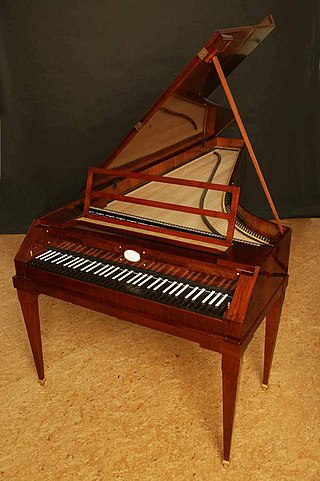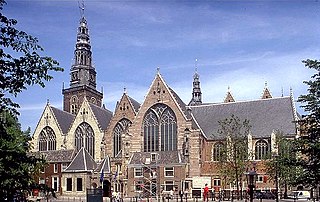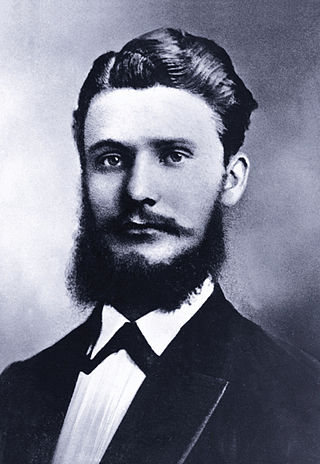
Partita was originally the name for a single-instrumental piece of music, but Johann Kuhnau, his student Christoph Graupner, and Johann Sebastian Bach used it for collections of musical pieces, as a synonym for suite.
A harpsichord concerto is a piece of music for an orchestra with the harpsichord in a solo role. Sometimes these works are played on the modern piano. For a period in the late 18th century, Joseph Haydn and Thomas Arne wrote concertos that could be played interchangeably on harpsichord, fortepiano, and pipe organ.

A fortepiano, sometimes referred to as a pianoforte, is an early piano. In principle, the word "fortepiano" can designate any piano dating from the invention of the instrument by Bartolomeo Cristofori in 1698 up to the early 19th century. Most typically, however, it is used to refer to the mid-18th to early-19th century instruments, for which composers of the Classical era, especially Haydn, Mozart, and the younger Beethoven and Hummel, wrote their piano music.
Ralph Leonard Kirkpatrick was an American harpsichordist and musicologist, widely known for his chronological catalog of Domenico Scarlatti's keyboard sonatas as well as for his performances and recordings.

The tangent piano is a very rare keyboard instrument that resembles a harpsichord and early pianos in design. It normally features five octaves of keys and the strings are acted upon by narrow wooden or metal slips when the keys are depressed.
Johannes Zumpe was a leading maker of early English square pianos, a form of rectangular piano with a compass of about five octaves. The pianos sounded like mellow harpsichords, and had a damper stop in the left cheek of the case. Zumpe is known as the creator of English square pianos.
The 17th century organ composers of Germany can be divided into two primary schools: the north German school and the south German school. The stylistic differences were dictated not only by teacher-pupil traditions and international influences, but also by separate organ building traditions: northern organs tend to have a tower layout with emphasis on the pedal division, while southern and Austrian instruments are typically divided around a window and emphasize manual divisions.

The Berlin Musical Instrument Museum is located at the Kulturforum on Tiergartenstraße in Berlin, Germany. The museum holds over 3,500 musical instruments from the 16th century onward and is one of the largest and most representative musical instrument collections in Germany. Objects include a portable harpsichord once owned by Prussia's Queen Sophie Charlotte, flutes from the collection of Frederick the Great, and Benjamin Franklin's glass harmonica.

Artus Gheerdinck (1564–1624) was a Dutch harpsichord builder.

Schiedmayer is the name of a German Instrument-manufacturing family. Established in 1735 as a keyboard instrument manufacturer, it is still active today as a family business.
Johann Sebastian Bach's music has been performed by musicians of his own time, and in the second half of the eighteenth century by his sons and students, and by the next generations of musicians and composers such as the young Beethoven. Felix Mendelssohn renewed the attention for Bach's music by his performances in the 19th century. In the 20th century Bach's music was performed and recorded by artists specializing in the music of the composer, such as Albert Schweitzer, Helmut Walcha and Karl Richter. With the advent of the historically informed performance practice Bach's music was prominently featured by artists such as Nikolaus Harnoncourt, Gustav Leonhardt and Sigiswald Kuijken.

The organ sonatas, BWV 525–530 by Johann Sebastian Bach are a collection of six sonatas in trio sonata form. Each of the sonatas has three movements, with three independent parts in the two manuals and obbligato pedal. The collection was put together in Leipzig in the late 1720s and contained reworkings of prior compositions by Bach from earlier cantatas, organ works and chamber music as well as some newly composed movements. The sixth sonata, BWV 530, is the only one for which all three movements were specially composed for the collection. When played on an organ, the second manual part is often played an octave lower on the keyboard with appropriate registration. Commentators have suggested that the collection might partly have been intended for private study to perfect organ technique, some pointing out that its compass allows it to be played on a pedal clavichord. The collection of sonatas is generally regarded as one of Bach's masterpieces for organ. The sonatas are also considered to be amongst his most difficult compositions for the instrument.

Friedrich ("Fritz") Karl Henkel was a German entrepreneur and founder of the Henkel Group.

Claude Mercier-Ythier was a French harpsichord maker who ran a shop and workshop in Paris dedicated exclusively to harpsichords. Instruments that he built and restored have been played in many concerts and recordings, including a recording of Bach's complete keyboard works by Zuzana Růžičková. He wrote a standard book on the topic, Les clavecins, published in 1990.
Ernst Gröschel was a German pianist. Gröschel studied with Emil von Sauer and others in Vienna. He is regarded as the first pianist who played Mozart and Beethoven completely on historical keyboard instruments. He was a member of the Bamberg Piano Quartet. He left behind a large number of recordings both on vinyl and in the archives of the Bayerischer Rundfunk.
The Gräbner family were German harpsichord-, clavichord-, organ- and eventually piano makers from the 17th century to the beginning of the 19th century. They are best known for their harpsichords, which represent a mid-german style of building, distinct from the better known northern style as represented by Hass, Mietke and Zell. The Gräbner family ran the most prominent instrument making workshop in Dresden, and were purveyors of harpsichords and organs to the court of Saxony. J.S. Bach was aquatinted with members of the Gräbner family and Christian Heinrich Gräbner studied organ playing under Bach.
Oliver Drechsel is a German concert pianist and composer.








